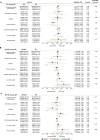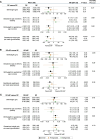Dihydroartemisinin-piperaquine plus sulfadoxine-pyrimethamine versus either drug alone for intermittent preventive treatment of malaria in pregnancy: A double-blind, randomized, controlled phase 3 trial from Uganda
- PMID: 40966190
- PMCID: PMC12445490
- DOI: 10.1371/journal.pmed.1004582
Dihydroartemisinin-piperaquine plus sulfadoxine-pyrimethamine versus either drug alone for intermittent preventive treatment of malaria in pregnancy: A double-blind, randomized, controlled phase 3 trial from Uganda
Abstract
Background: To mitigate adverse consequences of malaria in pregnancy, the World Health Organization recommends intermittent preventive treatment of malaria in pregnancy (IPTp) with sulfadoxine-pyrimethamine. However, the effectiveness of IPTp with sulfadoxine-pyrimethamine has been threatened by widespread Plasmodium falciparum resistance, especially in East and Southern Africa. For IPTp, dihydroartemisinin-piperaquine has shown superior antimalarial effects compared to sulfadoxine-pyrimethamine, but sulfadoxine-pyrimethamine has been associated with improved birth outcomes compared to dihydroartemisinin-piperaquine. We hypothesized that a combination of both dihydroartemisinin-piperaquine and sulfadoxine-pyrimethamine would provide superior birth outcomes compared to either drug alone.
Methods and findings: We conducted a double-blinded, randomized, controlled trial of 2,757 pregnant women in Uganda, where resistance of malaria parasites to sulfadoxine-pyrimethamine is widespread. Women were randomly assigned (1:1:1) to monthly IPTp with sulfadoxine-pyrimethamine, dihydroartemisinin-piperaquine, or dihydroartemisinin-piperaquine plus sulfadoxine-pyrimethamine. The primary outcome was the risk of a composite adverse birth outcome defined as any of the following: spontaneous abortion, stillbirth, low birthweight (LBW, < 2,500 g), preterm delivery (<37 weeks), small-for-gestational age, or neonatal death. Secondary outcomes included specific individual adverse birth outcomes, measures of malaria during pregnancy, and safety/tolerability. Combining dihydroartemisinin-piperaquine plus sulfadoxine-pyrimethamine did not reduce the risk of a composite adverse birth outcome compared to dihydroartemisinin-piperaquine (30.0% versus 30.9%, relative risk (RR) 0.97 [95% CI 0.84-1.12]; p = 0.70) or sulfadoxine-pyrimethamine (30.0% versus 26.4%, RR 1.14 [95% CI 0.98-1.33]; p = 0.10). The risk of a composite adverse birth outcome was higher with dihydroartemisinin-piperaquine compared to sulfadoxine-pyrimethamine (30.9% versus 26.4%, RR 1.17 [95% CI 1.01-1.36]; p = 0.04). Considering individual adverse birth outcomes, combining dihydroartemisinin-piperaquine plus sulfadoxine-pyrimethamine was associated with a higher risk of small-for-gestational age (23.4% versus 18.7%, RR 1.25 [95% CI 1.04-1.51]; p = 0.02) and low birthweight (8.6% versus 5.8%, RR 1.48 [95 CI 1.04-2.12]; p = 0.03) compared to sulfadoxine-pyrimethamine and a higher risk of preterm delivery (5.3% versus 3.1%, RR 1.73 [95% CI 1.07-2.79]; p = 0.03) compared to dihydroartemisinin-piperaquine. During pregnancy, compared to sulfadoxine-pyrimethamine, dihydroartemisinin-piperaquine was associated with a 94% reduction in the incidence of symptomatic malaria (0.46 versus 0.03 episodes per person-year, incidence rate ratio 0.06 [95% CI 0.03-0.12]; p < 0.001) and a 97% reduction in the risk of microscopic parasitemia (17.7% versus 0.6%, RR 0.03 [95% CI 0.02-0.05]; p < 0.001), but dihydroartemisinin-piperaquine plus sulfadoxine-pyrimethamine was not associated with improved malaria outcomes over dihydroartemisinin-piperaquine alone. There were no significant differences in the incidence of any grade 3-4 adverse events between the treatment arms. As this study was conducted in an area of high transmission intensity with widespread resistance to sulfadoxine-pyrimethamine, findings may not be generalizable to other settings.
Conclusions: Despite the superior antimalarial activity of dihydroartemisinin-piperaquine, sulfadoxine-pyrimethamine alone was associated with improved birth outcomes. Combining dihydroartemisinin-piperaquine plus sulfadoxine-pyrimethamine for IPTp did not improve birth outcomes compared to either sulfadoxine-pyrimethamine or dihydroartemisinin-piperaquine alone.
Trial registration: ClinicalTrials.gov (NCT04336189; https://clinicaltrials.gov/study/NCT04336189).
Copyright: © 2025 Kakuru et al. This is an open access article distributed under the terms of the Creative Commons Attribution License, which permits unrestricted use, distribution, and reproduction in any medium, provided the original author and source are credited.
Conflict of interest statement
The authors have declared that no competing interests exist.
Figures



Comment in
-
A need for new tools for prevention of malaria in pregnancy.PLoS Med. 2025 Sep 19;22(9):e1004729. doi: 10.1371/journal.pmed.1004729. eCollection 2025 Sep. PLoS Med. 2025. PMID: 40971346 Free PMC article.
References
-
- World Health Organization. World Malaria Report 2024: addressing inequity in the global malaria response. Geneva, Switzerland: World Health Organization; 2024.
-
- World Health Organization. WHO guidelines for malaria. World Health Organization; 2022.
-
- Roh ME, Gutman JR, Murphy M, Hill J, Madanitsa M, Kakuru A, et al. Dihydroartemisinin-piperaquine versus sulfadoxine-pyrimethamine for intermittent preventive treatment of malaria in pregnancy: a systematic review and individual participant data meta-analysis. EClinicalMedicine. 2025;83:103202. - PMC - PubMed
Publication types
MeSH terms
Substances
Associated data
Grants and funding
LinkOut - more resources
Full Text Sources
Medical
Research Materials

